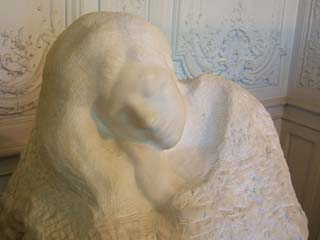 |
For me, contemporary sculpture begins with Rodin
because he had to navigate the transition to a twentieth century
aesthetic from what had been essentially Greek. His work is
figurative, classical in composition and he was definitely aspiring to
the same figurative standards as the old masters but he was affected by
the times to explore the limits of what could be accepted as
sculpture. He also had a modern affinity for scandal.
|

|
His "Le Penseur" (The
Thinker) is so well known as to have moved through cliché to
become an icon. I have seen this guy reproduced in everything
from
monumental bronzes to concrete garden sculptures and plastic dashboard
figures. Rodin's ability to capture the human figure and lifelike
(if sometimes poetic) human gestures make him popular with a wide range
of audiences.
|

|
I was surprised to
learn that "Le Penseur" started as just one figure in a complex
composition that depicted Dante's "Gates of Hell". In fact, it is
supposed to be Dante himself. The gates lingered on in Rodin's
work for some time and several of the subfigures became or contributed
to some of his best known pieces.
|
 |
"Le Baiser" (The
Kiss), started out as Paolo and Francesca within the gates but they
looked too happy and were sent out into the world on their own.
|

|
Rodin's monument to
the popular French novelist Balzac annoyed the people who commissioned
Rodin so much that they refused it and hired out the job to another
sculptor. It seems that the "Societe des Gens de Lettres" wanted
something more portrait like. This piece was not even cast until 22
years after Rodin's death. For many it is Rodin's best
piece.
|

|
Rodin liked to make
nude studies prior to draping them with clothing in order to get the
bone and muscle structures right. These are two earlier studies
of Balzac. These earlier studies were much more to the liking of
Rodin's clients.
|

|
Once Rodin became
established he eagerly hired out more of his work to workers who were
quite skilled but not famous. This practice continues to this
day. In this way, Rodin was responsible for over 1000 sculptures.
This piece is an early maquette of the marble in the following
frame called "Le Sommeil" (The Sleep). He used plaster, wax,
paper mache, fragments of earlier work, anything that was convenient to
communicate the basic composition to his helpers.
|

|
Being separate from,
yet overseeing, the process of converting a piece to stone led Rodin to
present some of his works in an early stage so that they appear to be
emerging from the stone. Though a common sight to those involved
in the production of sculpture this image of a figure emerging from
stone was a powerful idea to those accustomed only to seeing the
finished products.
|
 |
Another area that
Rodin explored was to deliberately lop off the limbs of some of his
pieces in order to more directly relate his work to the old and broken
Greek and Roman statues. Here are two versions of the same piece
one with a head and hands and one without.
|
 |
No current
discussion of Rodin would be complete without mentioning Camille
Claudel. She was a young sculptor who joined Rodin as a student
and became his mistress. Several of her ideas were incorporated
into Rodin's work and vise versa. She finally set out on her own
with some success but suffered from mental illness that ended
badly. Nearly a hundred years later her story resonated with many
and Rodin's reputation suffered in the retelling. Like many
issues surrounding Rodin there are those who will argue passionately
for him and others equally against him. It is surprising to me
that this continues so long after his death. Unfortunately, the
portion of the Rodin museum dedicated to Claudel was closed the day
that I visited.
It was telling to me that it was about this time
that Brancussi was invited by Rodin to join him but refused, making the
famous comment, "Nothing great can grow under the mighty oak."
|

|
This piece,
"walking man" has inspired several artists. Brancussi described
it at the time it was initially presented as "an inverted fork with two
tines stuck in the ground". Giacometti commented that he always
sculpted men walking and women standing still and used the same title
"Walking Man".
|
 |
One thing that
surprised me was the crappy bronze casting. Mold marks
everywhere, like this one running down the leg and across the foot of
this figure that were far too blatant to be mere mistakes.
Possibly no one dared make
the final decision of how to adjust the bronzes and Rodin was too
busy. Either Rodin was trying to include a record of the process
of creating the bronze or else the foundries were unanimously sloppy.
|
 |
The stonework was much
smoother but often retained the primary measuring points as odd little
pox. My guess is that they were kept as references until the last
possible moment.
In any case, it is clear that Rodin was aware of the
intermediate products of the work and opened them for interpretation.
|
|
|












